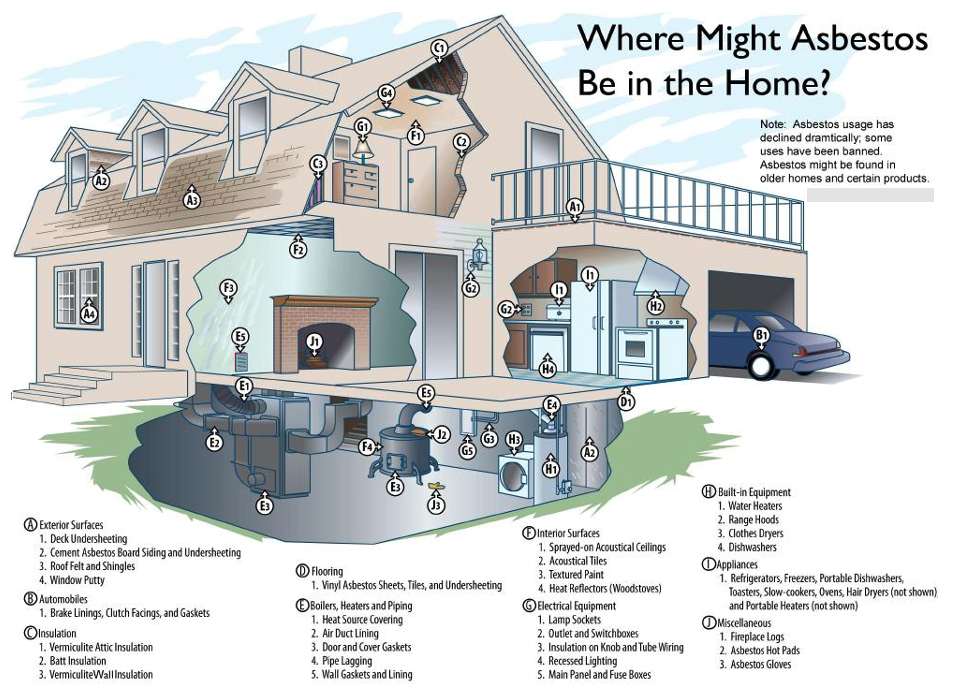 Asbestos the worlds Number 1 Killer
Asbestos the worlds Number 1 Killer
Asbestos is the greatest cause of work-related deaths in world. A million plus people die every year from asbestos-related diseases which typically take decades to develop and cannot be cured.
Safety Projects International Inc. has refreshed its guidance on asbestos to help you protect yourself and your workers.
Refreshed asbestos guidance, Our website has been updated to:
- Simplify the navigation to help you easily find the information you need
- remove outdated content and replace it with up-to-date, refreshed guidance
- The updated webpages include the following improvements: Introduction to asbestos safety
The following is astep guide explaining:
A) The dangers of asbestos, where you can find it and identifying if it is present
B) How to comply with the law, depending on your job role
C) How employers should carry out a risk assessment
D) Training and information for work involving asbestos
E) Summarises how to decide if a licensed asbestos contractor must do any work.
What is asbestos?
Asbestos is the generic name for 6 different naturally-occurring fibrous minerals, A “fibre” is defined as a particle that is more than 5 micrometres (μm) in length and having a length to width ratio of at least 3:1. Many countries like Canada have regulations which further adds that a fibre of asbestos must also be less than 3 μm wide.
Based on their physical and chemical properties, there are two major groups of asbestos: serpentine and amphibole.
Serpentine: Serpentine fibres are long, flexible and curved. These fibres can be woven together. The main type of serpentine asbestos is chrysotile (white asbestos), which is the main type of asbestos used in manufacturing.
Amphiobole: Amphibole fibres are straight and stiff. These fibres are generally brittle and rod- or needle-shaped, which limits their commercial usefulness. There are 5 sub-types of amphiobole asbestos, including:
Crocidolite (blue asbestos)
Amosite (brown asbestos)
Actinolite
Anthophyllite
Tremolite
What are the health effects of asbestos?
The human health effects from long-term unsafe asbestos exposure are well documented. Asbestos fibres are easily inhaled and carried into the lower regions of the lung where they can cause fibrotic lung disease (asbestosis) and changes in the lining of the chest cavity (pleura). These diseases can lead to reduced respiratory function and death. Long-term inhalation of asbestos fibres also increases the risk of lung cancer and mesothelioma.
Enlargement of the heart can also occur as an indirect effect from the increased resistance of blood flow through the lungs.
People are more likely to experience asbestos-related disorders if they:
- Are exposed to high concentrations of asbestos,
- Are exposed for longer periods of time, and/or
- Are exposed to asbestos more frequently.
Asbestosis is a chronic lung disease in which there is scar-like tissue formed in the lungs (pulmonary fibrosis). This fibrosis decreases the elasticity of the lungs, making breathing more difficult. Shortness of breath is the most common symptom. In most cases, a common physical sign is “crackles” – sounds that can be heard through a stethoscope. Also known as “rales”, they are usually detected near the end of a full inspiration.
When diagnosing asbestosis, chest x-rays will show small irregular opacities (spots in x-ray film where the x-rays could not “see” through the tissue). These are commonly found in the middle and lower lungs. Lung function tests can help to determine how serious the condition is. People with fully developed asbestosis have shortness of breath, cough, chest pain, reduced lung function, finger clubbing, and bluish skin colouration.
Development of asbestosis usually requires several years of exposure to asbestos fibres. The development and progression of asbestosis varies from individual to individual. It is often slow with little changes over five, ten or more years. Many cases do not advance after diagnosis. It may, however, be quicker in some individuals than in others due to different conditions of past dust exposure.
What is the risk of lung cancer from working with asbestos?
The risk of getting lung cancer after asbestos exposure depends on a number of factors, the most important of which are:
A) The level (how much) and the duration (length) of exposure.
B) The time since exposure occurred
C)The age at which exposure occurred.
D)The tobacco-smoking history of the exposed person, and
E) the type and size of the asbestos fibres.
The average time from exposure to cancer development (latency period) is 20 to 30 years. Although lung cancer is generally associated with long-term exposures to asbestos, there are also studies which show that workers with 1 to 12 months of exposure had an increased risk in developing lung cancer a number of years later.
Lung cancer has also been reported in household contacts and family members of asbestos workers, presumably from exposure to asbestos carried home on work clothes.
Lung cancer usually does not cause symptoms in the early stages. When symptoms occur the cancer is often advanced. Symptoms of lung cancer include chronic cough, weight loss, shortness of breath, fever, and chest pain. These symptoms are also common with other lung disorders, therefore to confirm the diagnosis it is necessary to carry out laboratory tests including chest x-rays.
What is mesothelioma?
Mesotheliomas are relatively rare in the general population, but are often observed in asbestos workers and sometimes in family/household members. Case-control studies have found strong associations between occupational exposure to asbestos fibres and the development of mesothelioma.
Malignant mesothelioma is an aggressive, usually fatal cancer arising from the mesothelial cells that form the lining of the pleural (lung), peritoneal (abdominal) and pericardial (heart) cavities. For mesothelioma, the latency is generally 30-40 years, with the longer periods seen where there had been lower levels of asbestos exposure. Workers with a heavy exposure probably swallow asbestos fibres (when fibres are cleared from the airways in mucous and then swallowed), which may contribute to the development of mesothelioma of the lining of the abdominal cavity (peritoneum).
Mesothelioma has also been reported in household contacts and family members of asbestos workers, presumably from exposure to asbestos carried home on work clothes.
Similar to lung cancer, several studies have indicated that the risk of mesothelioma after asbestos exposure depends on the time since exposure (latency), with the risk increasing exponentially with time after about 10 years. Early studies indicated that diagnosis with mesothelioma was fatal within a short period of time (often within months), however other studies indicate that survival time after diagnosis may be influenced by exposure intensity (amount).
Some scientists believe that early identification and intervention of mesothelioma may increase survival. In contrast to the situation for lung cancer, the effect of asbestos on mesothelioma risk does not appear to be increased by smoking.
Patients with pleural mesothelioma experience chest and shoulder pain and dry cough is frequent. As the cancer progresses and the tumor grows bigger, weight loss, weakness, and fever may also occur.
What are other health effects from asbestos?
Pleural Effects: Inhalation of asbestos fibres can also lead to four types of non-cancerous abnormalities in the lining of the chest cavity (pleura). These are: localized deposits of collagen (pleural plaques); fluid in the pleural space (pleural effusion); diffuse thickening and fibrosis of the pleura; and folded lung or rounded atelectasis (a condition which occurs when an area of pleural fibrosis rolls into the lung making a portion of the lung airless).
These pleural abnormalities are found in 10-60% of asbestos workers. Pleural abnormalities are also common in family members of asbestos workers, presumably from exposure to asbestos carried home on work clothes.
In many cases, the development of pleural plaques is not seen for 20 to 30 years after exposure. Pleural effusions (excess fluid between the two membranes that envelop the lungs) usually occur within 10 years after exposure.
Laryngeal Effects: Asbestos exposure has also been found to significantly increase the incidence of laryngitis in a small number of studies.
Immune System Effects
There have been several studies on the effects of asbestos exposure on the immune system. Most studies indicate that immune system function is reduced in workers with asbestosis. It has not been determined if the changes in immune function are the cause or the result of the asbestosis. In workers exposed to asbestos but who have not developed clinical signs of asbestosis, a depressed immune function is mild or no change has been noted.
Asbestos exposure may be a causal factor in the development of a rare condition known as retroperitoneal fibrosis. This condition is the development of a fibrous mass behind the membrane lining the abdominal cavity, which can result in kidney failure.
There is a case control study and there are a number of case reports which indicate that asbestos exposure may be an important risk factor for retroperitoneal fibrosis.
What occupations could be exposed to asbestos?
According to the U.S. Agency for Toxic Substances and Disease Registry (ATSDR) and the U.S. Occupational Safety and Health Administration (OSHA), asbestos exposure is a concern for the following workplaces and processes: Mining of asbestos occurring from natural mineral deposits
Processing of asbestos minerals (millers)
Manufacture of asbestos-containing products
Construction industry – disturbing asbestos-containing materials during building renovations or demolitions
Mechanics – vehicle brake and clutch repairs
Marinas – renovating or demolishing ships constructed with asbestos-containing materials
Insulation workers and heating trades
Sheet metal workers, plumbers and pipe fitters
Workers responsible for disposing of asbestos waste, and waste workers
Cement workers
Custodial workers – contact with deteriorating asbestos-containing materials in buildings
Guidance for the person who has a legal duty to manage asbestos in a building – the dutyholder. They must protect people from the risks of exposure to asbestos. This includes people who:
- work in their buildings
- use them in other ways
The step guide includes guidance on: what the legal duty is training for duty to manage, who the dutyholder is, depending on the type of building etc, what the dutyholder must do selecting a competent asbestos surveyor and checking the accuracy of the survey report, examples of how asbestos can be managed, new templates and examples of an asbestos register, a site plan and an asbestos management plan The duty to manage asbestos in buildings, A workers’ guide to asbestos safety
Guidance which explains what workers and their employers must do to protect themselves and others from asbestos.
It includes: what workers should do if they think they have found asbestos workers most likely to come across asbestos
Find out about: A workers’ guide to asbestos safety, This includes videos summarising the guidance for workers.
Locations of asbestos and taking the right action
This webpage includes an image gallery that can help you identify asbestos in typical locations and take the right action to minimise exposure.
Find out about: Locations of asbestos in homes, especially in older home.
 Although every effort is made to ensure the accuracy, currency and completeness of the information, Safety Projects International Inc. does not guarantee, warrant, represent or undertake that the information provided is correct, accurate or current.
Although every effort is made to ensure the accuracy, currency and completeness of the information, Safety Projects International Inc. does not guarantee, warrant, represent or undertake that the information provided is correct, accurate or current.
Bio:
Dr. Bill Pomfret of Safety Projects International Inc who has a training platform, said, “It’s important to clarify that deskless workers aren’t after any old training. Summoning teams to a white-walled room to digest endless slides no longer cuts it. Mobile learning is quickly becoming the most accessible way to get training out to those in the field or working remotely. For training to be a successful retention and recruitment tool, it needs to be an experience learner will enjoy and be in sync with today’s digital habits.”

